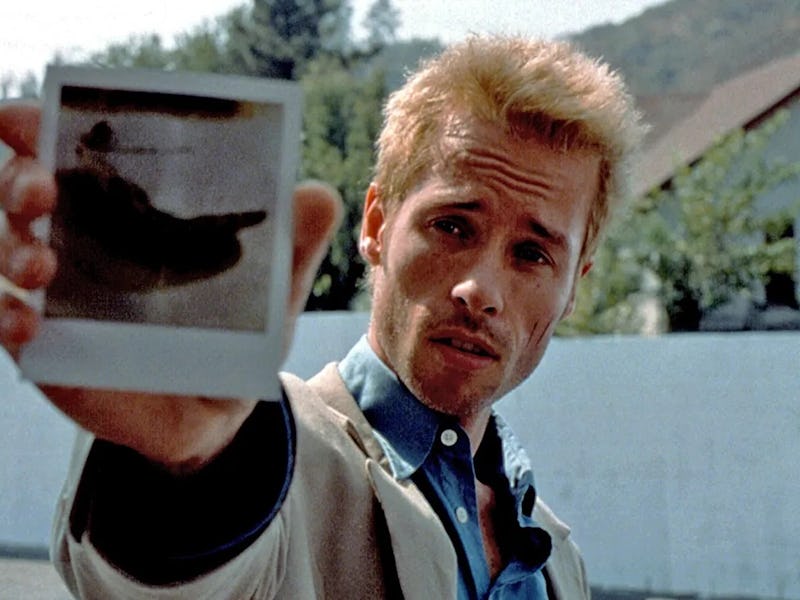One of the Most Important Sundance Successes Could Never Happen Today
We’ll never get another sleeper hit like Memento.

In January 2001, Christopher Nolan’s Memento was already the buzziest movie of the year, and it didn’t even have a distributor yet. The twisty crime thriller had made the rounds in the film festival circuit, premiering at the Venice Film Festival in August and slowly accumulating more acclaim until it made its last stop at the 2001 Sundance Film Festival. It was there Memento cemented its status as a cult classic, and established Nolan as an exciting auteur to watch.
Today, it’s considered one of those exceptional film festival discoveries that would go down as a modern classic or become the launchpad of a bright career. Certainly, we wouldn’t have had the towering achievement that is Nolan’s Oppenheimer if it weren’t for Memento. And with Memento, Nolan would start to usurp M. Night Shyamalan as the director who could pull off a particularly satisfying twist; it’s hard to watch any nonlinear thriller without thinking of his movie.
But even with its celebrated film festival run, Memento had so much trouble reaching audiences that it might not have become a beloved classic at all. Its rise to bonafide masterpiece status (it’s been selected for preservation in the National Film Registry) is a testament to a movie landscape that was much kinder to independent films, but is quickly fading from existence.
Memento was actually a dual effort from Christopher Nolan and his brother Jonathan. Though Christopher Nolan wrote and directed the movie, it was based on the short story “Memento Mori” by the younger Nolan, who would forge his own TV and movie career with equally twisty projects. Its star, Guy Pearce, plays Leonard Shelby, a former insurance investigator who has anterograde amnesia, a condition he gained after two men raped and killed his wife, while leaving him with a head injury so severe he can’t retain recent memories. Left with only his pre-attack memories, Leonard vows to find the killer who escaped, and tattoos himself with clues to help himself.
What set Memento apart from other revenge stories was its structure. The film takes place over two timelines: one chronological and shot in black and white, the other a color sequence in reverse. The latter mimics Leonard’s experience of only remembering things a few minutes at a time. Leonard finds himself dropped into scenarios where he has to figure out what’s happening, sometimes for comedic effect (Nolan’s dry sense of humor has never been better represented by the “What am I doing? Oh, I’m chasing this guy. No, he’s chasing me” scene), but mostly to convey the feeling of being trapped in a noir created by your own mind.
The neo-noir was enjoying a mini resurgence thanks to films like Rian Johnson’s Brick, and this structurally complex approach helped make the genre feel fresh for the first time in decades. Some might call it a gimmick, but the feeling of watching Memento for the first time cannot be beat. It makes you suddenly sit up, realize what’s happening, and feel the movie demanding your attention. It’s the kind of smart and thrilling filmmaking Nolan would make a career of.
Memento’s unique reverse-chronological structure was its biggest success and hurdle.
But Memento’s reverse chronological timeline would almost prevent it from reaching audiences. Despite the festival circuit adulation it received, it had a surprisingly difficult time finding a distributor. Studio executives, including now-disgraced Miramax chief Harvey Weinstein, thought it too confusing, and potentially alienating for audiences. Indie director extraordinaire Steven Soderbergh championed the film, but even he couldn’t get it a distributor. Eventually its financier, Newmarket, decided to distribute the movie itself. Lo and behold, it became a sleeper hit, earning $25 million and prompting Weinstein to renege his rejection and unsuccessfully try to buy the film from Newmarket.
Memento was a true independent success: Nolan edited the trailers himself, while Jonathan Nolan created a promo website that tried to tap into The Blair Witch Project’s brand of viral marketing. Revisiting Memento today, it’s sad to think such a surprise success couldn’t happen again.
Today, the best hope indie directors have is to get picked up by streamers, be dumped into an endless sea of content, and hope they somehow stand out. A24 and NEON have become the last strongholds of the indie circuit, but their brands supersede the filmmakers themselves. Gone are the days when a filmmaker could write and direct a movie, edit his own trailers, and become such a success his name alone brings audiences to theaters. Memento remains a thrill, but it’s also a reminder that there are still gems to be found in the independent film festival circuit, if only we’re willing to go looking.